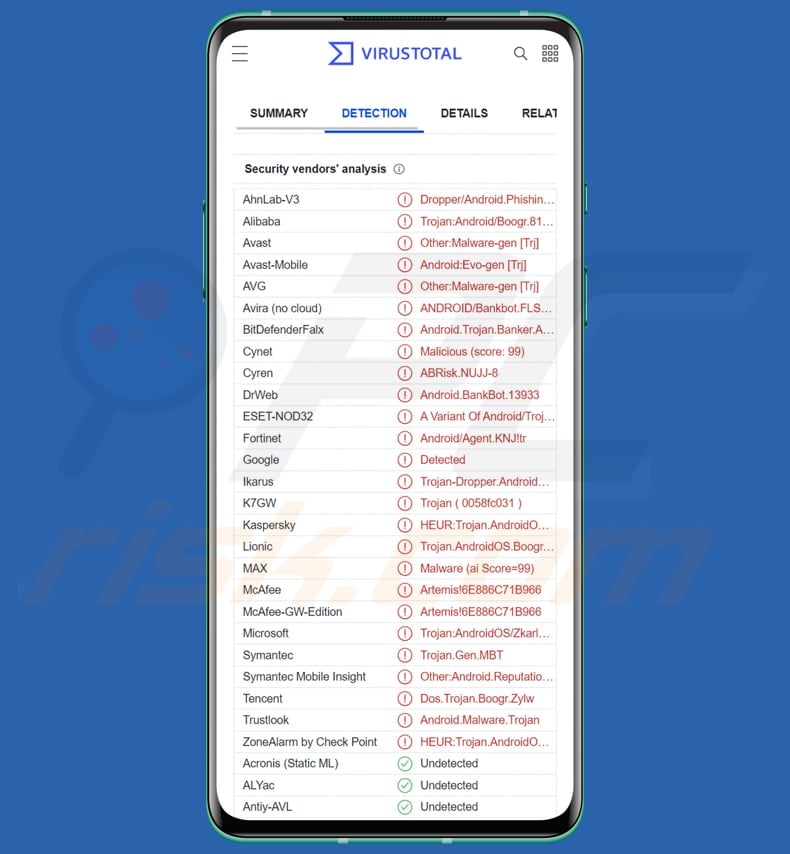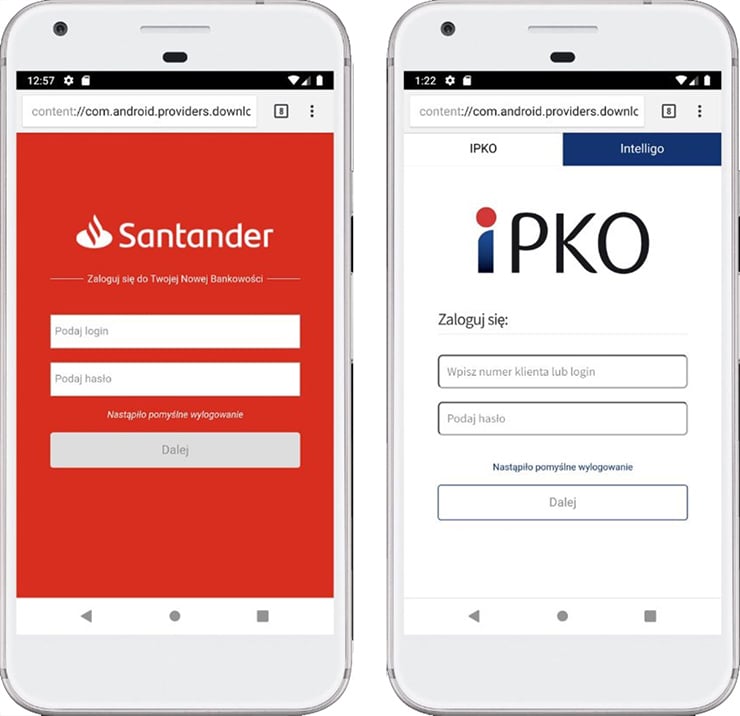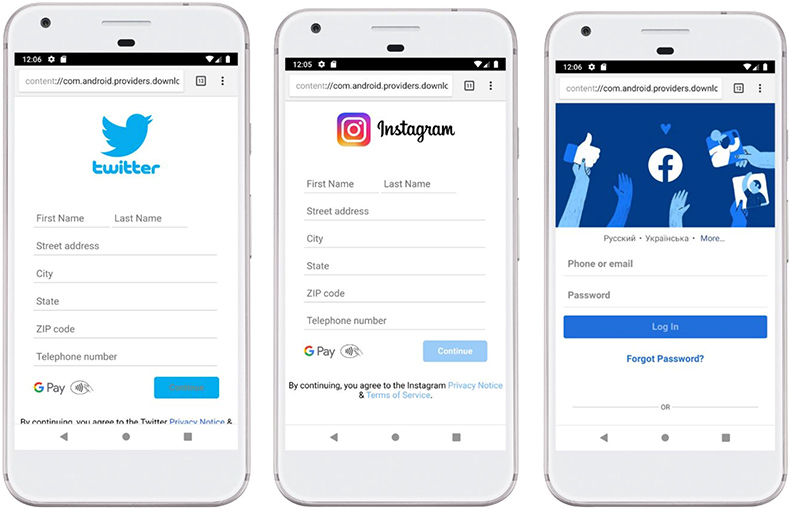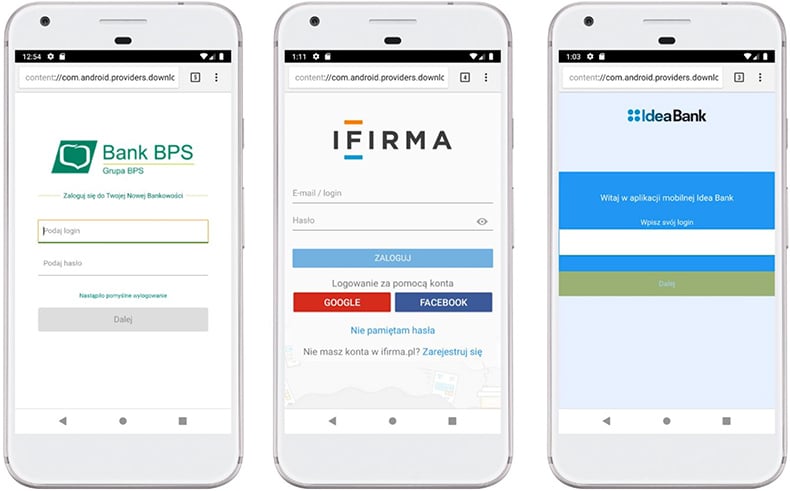Get free scan and check if your device is infected.
Remove it nowTo use full-featured product, you have to purchase a license for Combo Cleaner. Seven days free trial available. Combo Cleaner is owned and operated by RCS LT, the parent company of PCRisk.com.
What kind of malware is Hook?
Hook (also known as Hookbot) is a banking malware targeting Android users. Hook allows cybercriminals to remotely interact with the infected device's screen, exfiltrate files, steal seed phrases from cryptocurrency wallets, perform overlay attacks, and more. Hook malware should be removed from infected devices immediately.

Hook malware overview
Hook has Remote Access Tool capabilities that are implemented using Accessibility Services. It can perform a full device takeover (DTO). This feature enables threat actors to perform a wide range of malicious activities.
Hook's RAT module allows threat actors to perform specific swipe gestures, take screenshots, simulate clicks at specific text items, simulate key presses, unlock device scroll up and down, simulate long press events, start and remove specified applications, enable call forwarding, send text messages, open specified URLs, and more.
Also, Hook can be used to retrieve a list of files stored on the infected device and download specific files. Furthermore, this malware can extract seed phrases from Bitcoin, Trust, Mycelium, Blockchain, Samourai, Coinbase, MetaMask, and SafePal cryptocurrency wallets.
Additionally, Hook can be used to open WhatsApp, log and send messages via this application, and receive the victim's geolocation. Other capabilities include SMS interception, contact harvesting, call control, 2FA and email stealing, keylogging, antivirus evasion, and removal prevention.
As mentioned in the introduction, Hook can perform overlay attacks. It can display fake windows over legitimate apps. This feature is used to steal sensitive information (e.g., to trick users into entering login information on fake login forms).
It targets a large number of various banking apps (e.g., HSBC, Deutsche Bank, Inbank, and Barclays banking apps) and social apps (e.g., Snapchat, Airbnb, Netflix, WeChat, Tinder, Telegram, and other apps).
| Name | Hook banking malware |
| Threat Type | Android malware, Spyware, Remote Access Trojan |
| Detection Names | Avast (Other:Malware-gen [Trj]), BitDefenderFalx (Android.Trojan.Banker.ACJ), ESET-NOD32 (A Variant Of Android/TrojanDropper.Agent.KNJ), Kaspersky (HEUR:Trojan.AndroidOS.Boogr.gsh), Full List (VirusTotal) |
| Symptoms | The device is running slow, system settings are modified without user's permission, questionable applications appear, data and battery usage is increased significantly, browsers redirect to questionable websites, push notifications are delivered, calls are forwarded to unknown numbers. |
| Distribution methods | Fake Chrome browers distributed using Telegram, phishing campaigns, and possibly dropper apps on Google Play. |
| Damage | Stolen personal information (private messages, logins/passwords, credit card details, files, etc.), decreased device performance, battery is drained quickly, decreased Internet speed, huge data losses, monetary losses, stolen identity, hijacked online accounts. |
| Malware Removal (Windows) |
To eliminate possible malware infections, scan your computer with legitimate antivirus software. Our security researchers recommend using Combo Cleaner. Download Combo CleanerTo use full-featured product, you have to purchase a license for Combo Cleaner. 7 days free trial available. Combo Cleaner is owned and operated by RCS LT, the parent company of PCRisk.com. |
Possible damage
Having a powerful Android malware allowing threat actors to steal various sensitive information that could be used to steal money, online accounts, identities, etc. Also, Hook can be used to trick other users into infecting their devices (and providing information, sending money, etc.). Thus, it must be removed from the infected device as soon as possible.
More examples of Android malware are Pegasus, GodFather, and BrasDex.
How did Hook infiltrate my device?
Hook masquerades as the Google Chrome web browser and possibly other apps to lure unsuspecting users into downloading malware. It is likely that cybercriminals distribute Hook via phishing campaigns, Telegram channels, or use Google Play Store to trick users into installing dropper apps.
How to avoid installation of malware?
Read reviews of applications before downloading them. Do not download apps from questionable sources. Download them from official websites and stores only. Avoid clicking suspicious links received via email or SMS. Keep the Google Play Protect always enabled and all installed apps updated. Do not trust advertisements on shady websites. Use reputed antivirus software.
Examples of Hook malware's activity (image source: Urząd Komisji Nadzoru Finansowego):
Screen overlay in various banking apps:

Impersonating social networks:

Impersonating various applications:

Update December 4, 2024 – Hook malware has been observed being spread under the guise of various legitimate apps. It has impersonated and used overlays for over 400 applications, including Airbnb, Bank of Queensland, Citibank, Coinbase, Facebook, Google Chrome, PayPal, Tesco Mobile, etc. Some of the disguises are incredibly sophisticated, while others are generic.
Hook can even change disguises; it has been noted infiltrating systems and asking for various permissions as Facebook, and afterward renaming itself and changing the disguise to the Google Chrome browser. Additionally, the malware can self-update through the data and commands received from its C&C (Command and Control) server.
It is pertinent to mention that Hook is highly customizable, as the cyber criminals who have purchased it may gain access to its builder and thus reconfigure it to satisfy their needs. Hence, the disguises used by Hook and targeted information can differ drastically between the variants.
Hook malware initially disguised as Facebook and changing its disguise to Google Chrome (image source – Netcraft):
Update August 26, 2025 – new variant of Hook malware has been discovered. This version has screenlocker-type ransomware capabilities. Once this functionality is activated, the victim is presented with a full-screen "warning" message demanding payment in cryptocurrency for access recovery (ransom amount and cryptowallet address differ between attacks).
Quick menu:
- Introduction
- How to delete browsing history from the Chrome web browser?
- How to disable browser notifications in the Chrome web browser?
- How to reset the Chrome web browser?
- How to delete browsing history from the Firefox web browser?
- How to disable browser notifications in the Firefox web browser?
- How to reset the Firefox web browser?
- How to uninstall potentially unwanted and/or malicious applications?
- How to boot the Android device in "Safe Mode"?
- How to check the battery usage of various applications?
- How to check the data usage of various applications?
- How to install the latest software updates?
- How to reset the system to its default state?
- How to disable applications that have administrator privileges?
Delete browsing history from the Chrome web browser:

Tap the "Menu" button (three dots on the right-upper corner of the screen) and select "History" in the opened dropdown menu.

Tap "Clear browsing data", select "ADVANCED" tab, choose the time range and data types you want to delete and tap "Clear data".
Disable browser notifications in the Chrome web browser:

Tap the "Menu" button (three dots on the right-upper corner of the screen) and select "Settings" in the opened dropdown menu.

Scroll down until you see "Site settings" option and tap it. Scroll down until you see "Notifications" option and tap it.

Find the websites that deliver browser notifications, tap on them and click "Clear & reset". This will remove permissions granted for these websites to deliver notifications. However, once you visit the same site again, it may ask for a permission again. You can choose whether to give these permissions or not (if you choose to decline the website will go to "Blocked" section and will no longer ask you for the permission).
Reset the Chrome web browser:

Go to "Settings", scroll down until you see "Apps" and tap it.

Scroll down until you find "Chrome" application, select it and tap "Storage" option.

Tap "MANAGE STORAGE", then "CLEAR ALL DATA" and confirm the action by taping "OK". Note that resetting the browser will eliminate all data stored within. This means that all saved logins/passwords, browsing history, non-default settings and other data will be deleted. You will also have to re-login into all websites as well.
Delete browsing history from the Firefox web browser:

Tap the "Menu" button (three dots on the right-upper corner of the screen) and select "History" in the opened dropdown menu.

Scroll down until you see "Clear private data" and tap it. Select data types you want to remove and tap "CLEAR DATA".
Disable browser notifications in the Firefox web browser:

Visit the website that is delivering browser notifications, tap the icon displayed on the left of URL bar (the icon will not necessarily be a "Lock") and select "Edit Site Settings".

In the opened pop-up opt-in the "Notifications" option and tap "CLEAR".
Reset the Firefox web browser:

Go to "Settings", scroll down until you see "Apps" and tap it.

Scroll down until you find "Firefox" application, select it and tap "Storage" option.

Tap "CLEAR DATA" and confirm the action by taping "DELETE". Note that resetting the browser will eliminate all data stored within. This means that all saved logins/passwords, browsing history, non-default settings and other data will be deleted. You will also have to re-login into all websites as well.
Uninstall potentially unwanted and/or malicious applications:

Go to "Settings", scroll down until you see "Apps" and tap it.

Scroll down until you see a potentially unwanted and/or malicious application, select it and tap "Uninstall". If, for some reason, you are unable to remove the selected app (e.g., you are prompted with an error message), you should try using the "Safe Mode".
Boot the Android device in "Safe Mode":
The "Safe Mode" in Android operating system temporarily disables all third-party applications from running. Using this mode is a good way to diagnose and solve various issues (e.g., remove malicious applications that prevent users you from doing so when the device is running "normally").

Push the "Power" button and hold it until you see the "Power off" screen. Tap the "Power off" icon and hold it. After a few seconds the "Safe Mode" option will appear and you'll be able run it by restarting the device.
Check the battery usage of various applications:

Go to "Settings", scroll down until you see "Device maintenance" and tap it.

Tap "Battery" and check the usage of each application. Legitimate/genuine applications are designed to use as low energy as possible in order to provide the best user experience and to save power. Therefore, high battery usage may indicate that the application is malicious.
Check the data usage of various applications:

Go to "Settings", scroll down until you see "Connections" and tap it.

Scroll down until you see "Data usage" and select this option. As with battery, legitimate/genuine applications are designed to minimize data usage as much as possible. This means that huge data usage may indicate presence of malicious application. Note that some malicious applications might be designed to operate when the device is connected to wireless network only. For this reason, you should check both Mobile and Wi-Fi data usage.

If you find an application that uses a lot of data even though you never use it, then we strongly advise you to uninstall it as soon as possible.
Install the latest software updates:
Keeping the software up-to-date is a good practice when it comes to device safety. The device manufacturers are continually releasing various security patches and Android updates in order to fix errors and bugs that can be abused by cyber criminals. An outdated system is way more vulnerable, which is why you should always be sure that your device's software is up-to-date.

Go to "Settings", scroll down until you see "Software update" and tap it.

Tap "Download updates manually" and check if there are any updates available. If so, install them immediately. We also recommend to enable the "Download updates automatically" option - it will enable the system to notify you once an update is released and/or install it automatically.
Reset the system to its default state:
Performing a "Factory Reset" is a good way to remove all unwanted applications, restore system's settings to default and clean the device in general. However, you must keep in mind that all data within the device will be deleted, including photos, video/audio files, phone numbers (stored within the device, not the SIM card), SMS messages, and so forth. In other words, the device will be restored to its primal state.
You can also restore the basic system settings and/or simply network settings as well.

Go to "Settings", scroll down until you see "About phone" and tap it.

Scroll down until you see "Reset" and tap it. Now choose the action you want to perform:
"Reset settings" - restore all system settings to default;
"Reset network settings" - restore all network-related settings to default;
"Factory data reset" - reset the entire system and completely delete all stored data;
Disable applications that have administrator privileges:
If a malicious application gets administrator-level privileges it can seriously damage the system. To keep the device as safe as possible you should always check what apps have such privileges and disable the ones that shouldn't.

Go to "Settings", scroll down until you see "Lock screen and security" and tap it.

Scroll down until you see "Other security settings", tap it and then tap "Device admin apps".

Identify applications that should not have administrator privileges, tap them and then tap "DEACTIVATE".
Frequently Asked Questions (FAQ)
What are the biggest issues that malware can cause?
Malware can be used to steal money and identities, hijack online accounts, make fraudulent purchases, encrypt files, inject additional malware, mine cryptocurrency, and more.
What is the purpose of Hook malware?
Hook is a banking malware with the capabilities of a Remote Access Trojan. It can perform overlay attacks, extract seed phrases from cryptocurrency wallets, log keystrokes, download files, open websites, and perform many other tasks. More information about the Hook malware is provided in our article above.
How did Hook malware infiltrate my computer?
It is known that Hook infects devices via fake Google Chrome browsers. Cybercriminals are using Telegram channels and phishing campaigns to trick users into infecting devices with Hook. Also, they may be using trojanized apps (droppers) on Google Play Store.
Will Combo Cleaner protect me from malware?
Yes, Combo Cleaner removes malware from infected devices. It can detect almost all known malware. High-end malware usually hides deep in the system. Therefore, victims must run a full system scan to remove it.
Share:

Tomas Meskauskas
Expert security researcher, professional malware analyst
I am passionate about computer security and technology. I have an experience of over 10 years working in various companies related to computer technical issue solving and Internet security. I have been working as an author and editor for pcrisk.com since 2010. Follow me on Twitter and LinkedIn to stay informed about the latest online security threats.
PCrisk security portal is brought by a company RCS LT.
Joined forces of security researchers help educate computer users about the latest online security threats. More information about the company RCS LT.
Our malware removal guides are free. However, if you want to support us you can send us a donation.
DonatePCrisk security portal is brought by a company RCS LT.
Joined forces of security researchers help educate computer users about the latest online security threats. More information about the company RCS LT.
Our malware removal guides are free. However, if you want to support us you can send us a donation.
Donate

▼ Show Discussion